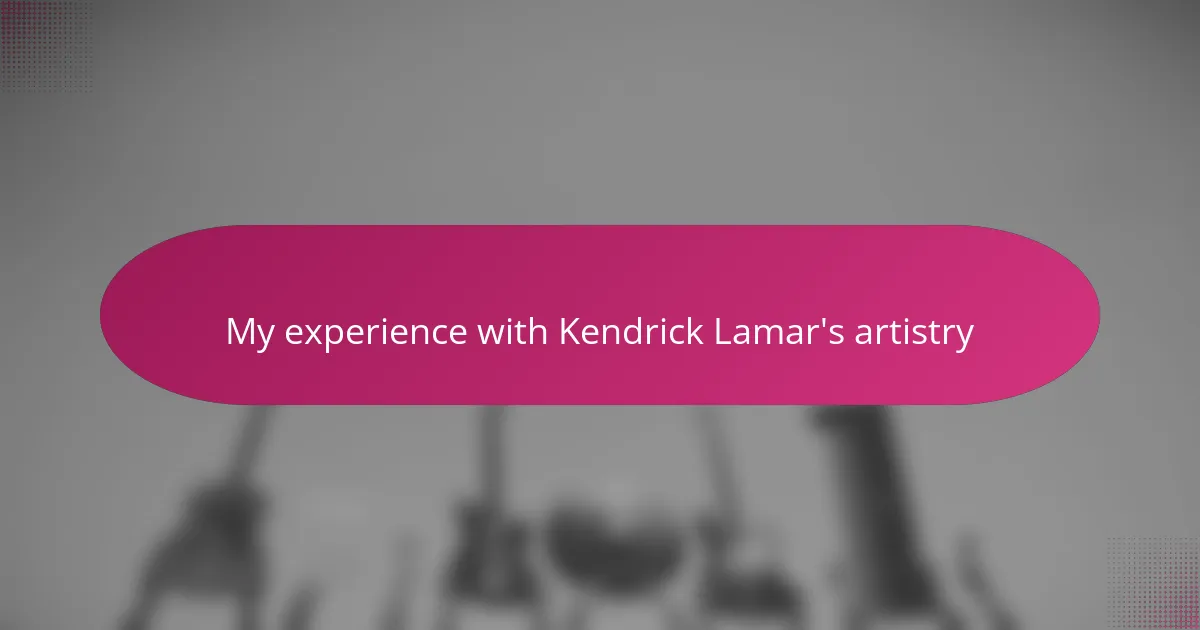Key takeaways
- Kendrick Lamar’s artistry is characterized by deep personal storytelling that addresses social and cultural issues, making his lyrics relatable and impactful.
- His innovative use of rhythm and emotional flow transforms rap into a powerful medium for social change, inspiring authenticity in other artists.
- Kendrick’s vulnerability in his lyrics fosters a strong connection with listeners, encouraging them to reflect on their own experiences and struggles.
- His creative techniques, such as layering meanings and adjusting flow to match emotional content, can serve as valuable lessons for aspiring rappers.
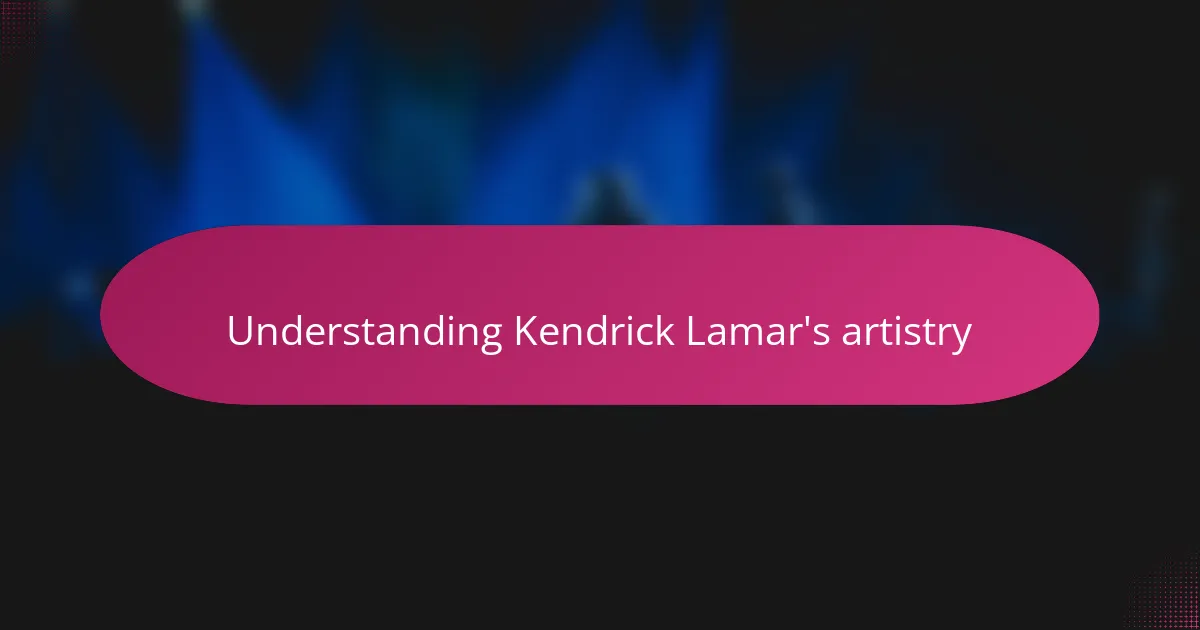
Understanding Kendrick Lamar’s artistry
What strikes me most about Kendrick Lamar’s artistry is how deeply personal and raw his storytelling is. Have you ever felt like a song was speaking directly to your own experiences, even if they’re worlds apart? That’s the power of his lyricism—he weaves complex narratives that resonate on an emotional level while addressing social and cultural issues.
The way Kendrick blends sharp poetic devices with rhythm and melody is nothing short of masterful. His music isn’t just about catchy beats; it’s a carefully crafted art form where every word matters. I remember the first time I really listened to good kid, m.A.A.d city, and how it opened my eyes to the idea that rap could be both introspective and socially conscious without sacrificing excitement.
What really sets Kendrick apart is his fearless exploration of identity and struggle, inviting listeners to reflect alongside him. Can you think of any other artist who so seamlessly balances vulnerability with strength? This intricate balance in his work keeps me coming back, eager to uncover new layers each time I listen.
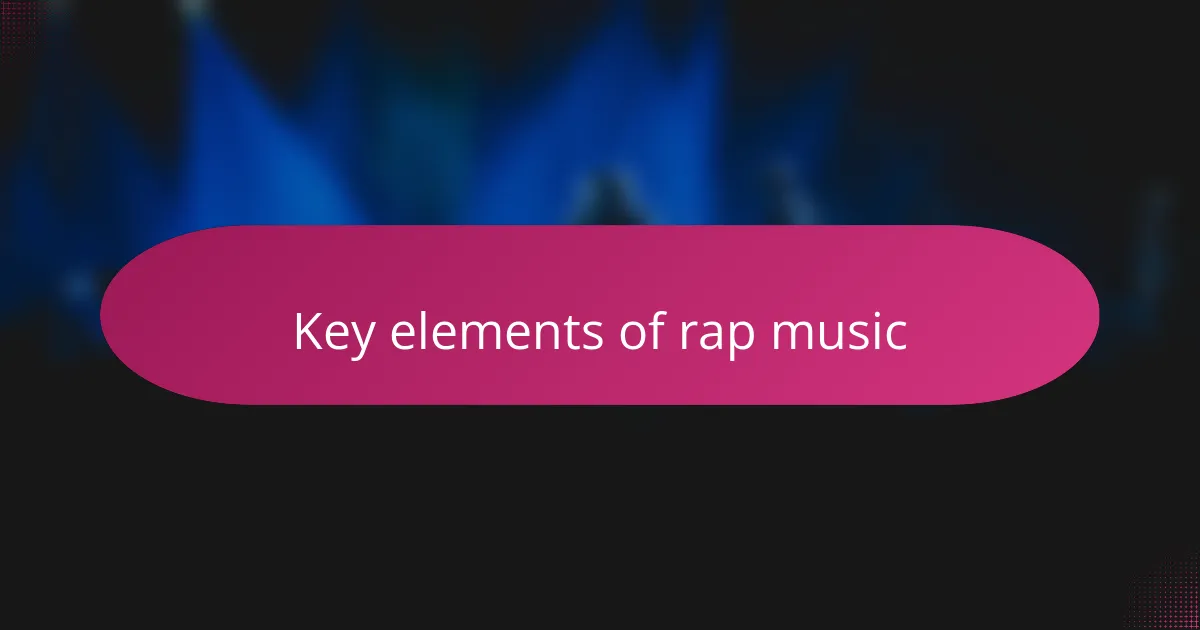
Key elements of rap music
Rap music, at its core, thrives on rhythm and wordplay. The beat sets the stage, but it’s the flow—the way an artist rides that beat with cadence and timing—that truly brings the song to life. I’ve often found myself rewinding tracks just to catch how perfectly Kendrick shifts his delivery, making every syllable hit with purpose.
Lyrics are the heartbeat of rap, and storytelling is where it shines brightest. Why do certain songs feel like they were written just for you? For me, it’s because great rappers paint vivid pictures with their words, sharing stories of triumph, struggle, and everything in between. Kendrick’s ability to tell these stories with honesty and nuance always makes his music feel personal, no matter your background.
Of course, there’s also the cultural and social commentary that gives rap its depth. It’s more than entertainment; it’s a platform for voices that often go unheard. When I listen to albums that address real-world issues, I’m reminded how rap can challenge perspectives and spark conversation. Kendrick’s work excels here, making each track feel like a call to awareness wrapped in compelling artistry.
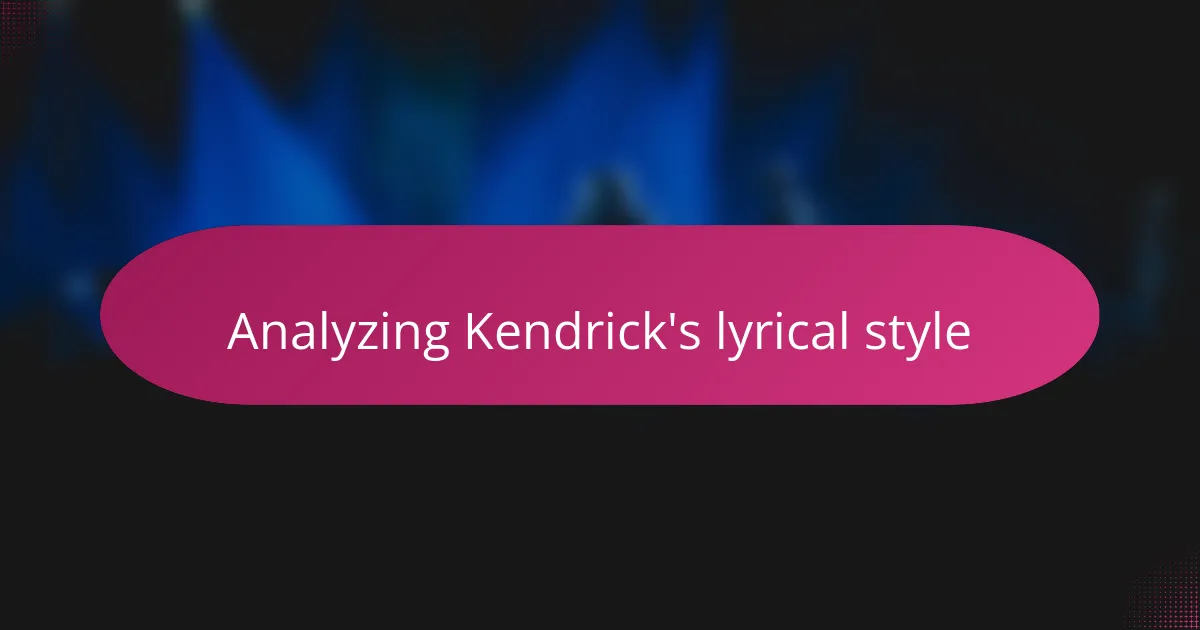
Analyzing Kendrick’s lyrical style
Kendrick’s lyrical style stands out because of his masterful use of metaphor and wordplay. I’ve noticed how he layers meanings within single lines, making you pause and think—sometimes even replay the verse just to catch every nuance. Have you ever caught a clever double entendre in his verses that completely changed your understanding of the song? That’s the kind of depth he puts into his lyrics.
What really fascinates me is how Kendrick manipulates his flow to match the emotion of his words. Whether it’s the rapid-fire delivery in DNA. or the contemplative cadence in Sing About Me, his rhythms feel alive, almost like an extension of his voice’s emotional weight. Listening closely, I realized it’s not just what he says, but how he says it that pulls me in every time.
I also appreciate how Kendrick’s lyricism doesn’t shy away from vulnerability. He openly explores fear, doubt, and pain, which adds a raw authenticity to his storytelling. It makes me wonder, how many artists are brave enough to expose their inner struggles in such a public way? For me, this fearless honesty is what makes his lyrics so powerful and relatable.
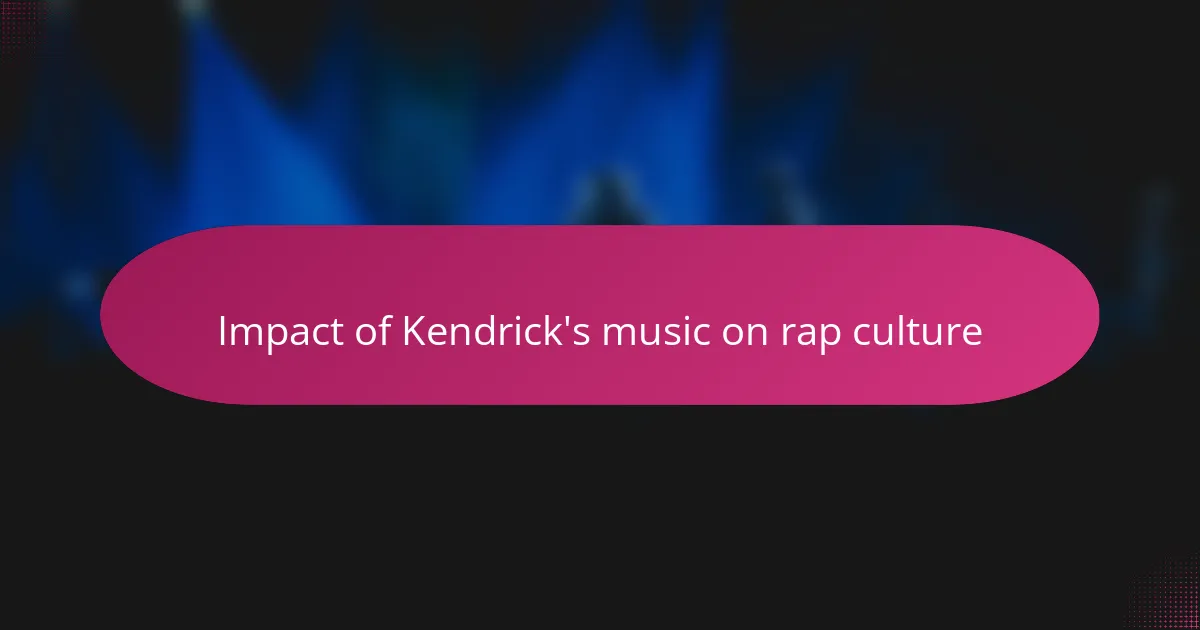
Impact of Kendrick’s music on rap culture
Kendrick Lamar’s impact on rap culture feels monumental to me because he reshaped what rap could be—transforming it from mere entertainment into a profound vehicle for social change. When I first heard how his songs tackled issues like systemic racism and personal trauma without losing artistic flair, it made me rethink the potential of rap as a force for awareness and empowerment. Isn’t it powerful when music challenges the culture around it while still staying true to its roots?
I’ve also noticed how Kendrick inspired a new wave of artists to prioritize authenticity over commercial appeal. His willingness to share his vulnerabilities and complexities set a new standard, encouraging rappers to explore deeper themes rather than sticking to clichéd bravado. It makes me ask: how often do we celebrate raw honesty in rap, and how much more vibrant would the culture be if more artists followed Kendrick’s example?
From a fan’s perspective, Kendrick’s influence isn’t just about the music itself but the conversations it sparks within communities. His albums often become cultural events that prompt reflection and dialogue about identity, struggle, and resilience. I’ve personally seen friends and strangers alike dissect his lyrics with passion, proving that his artistry extends far beyond the headphones into everyday life. Can you recall the last time an album pushed you to think this hard? For me, that’s Kendrick’s lasting gift to rap culture.
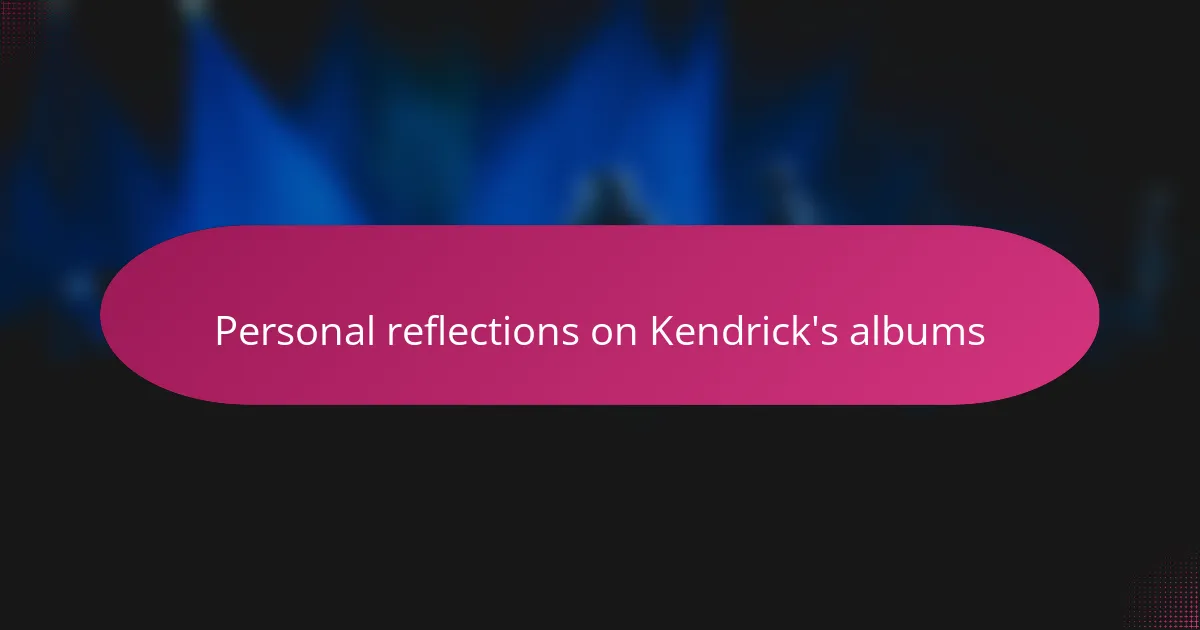
Personal reflections on Kendrick’s albums
Listening to Kendrick’s albums is like entering different chapters of his life—and somehow, mine too. When I first dove into To Pimp a Butterfly, I was struck by how raw and experimental it felt, as if Kendrick was challenging not just the music industry but my own ideas about what rap could be. Have you ever had an album that makes you rethink the entire genre? That’s exactly how this one hit me.
DAMN. felt different—it was more direct, almost like Kendrick was having a one-on-one conversation with me. The way he flips between humility and confidence reminded me of times in my own life when I wrestled with doubt and pride. I found myself coming back to that album during moments of uncertainty, searching for answers in his honest reflections.
Then there’s good kid, m.A.A.d city, which still feels like a timeless narrative. I remember sharing that album with friends, each of us connecting to its stories of youth, temptation, and survival in our own ways. It’s rare that an album can be so personal yet universal, and Kendrick somehow achieves it effortlessly. Doesn’t that speak to the true power of his artistry?
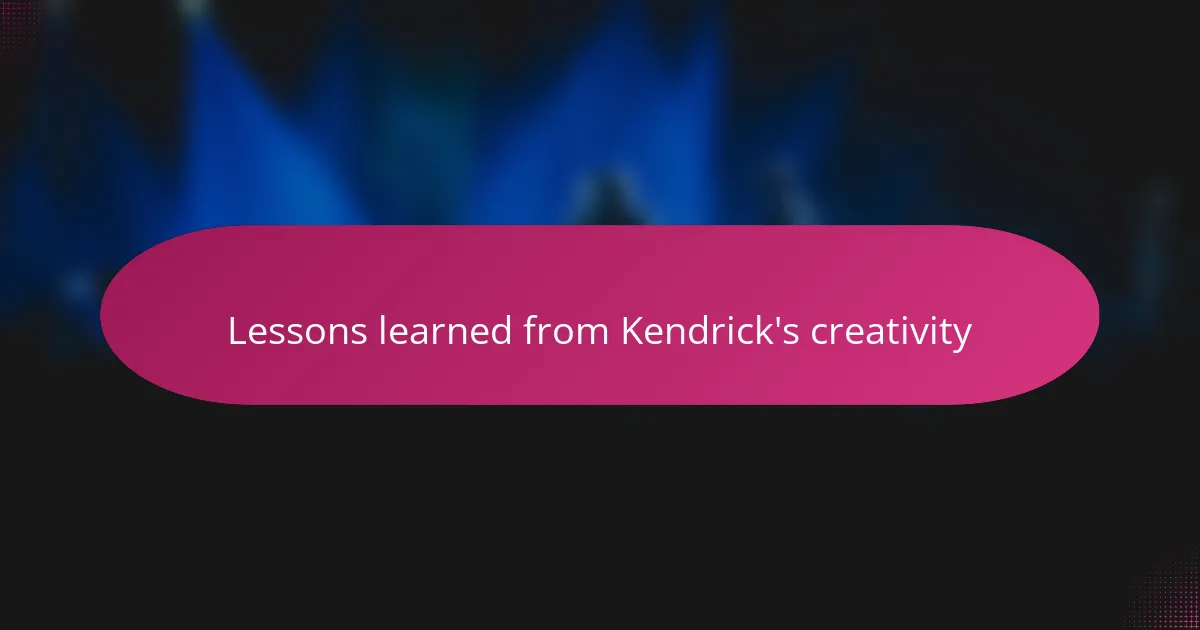
Lessons learned from Kendrick’s creativity
One lesson Kendrick’s creativity has taught me is the importance of vulnerability in art. Watching him lay bare his fears and struggles makes me realize how much power there is in embracing imperfections, rather than hiding them. Have you ever noticed how his honest expression makes the music feel more like a conversation than a performance? To me, that authenticity is the heartbeat of his creativity.
Another insight I gained is how innovation and respect for tradition can coexist beautifully. Kendrick’s willingness to experiment with jazz, funk, and spoken word, all while honoring hip-hop’s roots, reminded me that creativity flourishes when you build on what came before instead of ignoring it. This balance challenges me to think beyond conventional boundaries in my own work and everyday problem-solving.
Finally, Kendrick’s work shows me that creativity isn’t just about aesthetics—it carries responsibility. His art provokes thought, sparks dialogue, and shines light on issues many avoid. This makes me ask: How can I use my own creative voice not just to entertain, but to inspire change? Thinking about this, I understand why Kendrick’s artistry resonates so deeply—it’s creativity with a purpose.

Applying Kendrick’s techniques to rap writing
Applying Kendrick’s techniques to my own rap writing has been both challenging and rewarding. I’ve tried to adopt his layering of meanings, where a single line can carry multiple interpretations. It pushes me to think beyond surface-level rhymes and write verses that invite listeners to pause and reflect—just like Kendrick’s lyrics made me do.
One practical approach I took was experimenting with shifting my flow to match the emotional tone of my lyrics. When I heard how he speeds up or slows down depending on the mood, I realized it’s not just about words but how those words feel. Trying this out made my writing sessions feel more alive; I wasn’t just telling a story, I was embodying it through rhythm.
Have you ever struggled to balance personal vulnerability with confidence in your writing? That tension is something Kendrick navigates so masterfully, and it inspired me to be braver in expressing my own doubts and strengths. Opening up like that doesn’t just improve the song—it creates a genuine connection with anyone listening.
